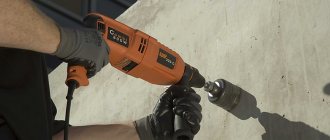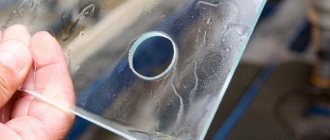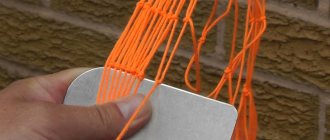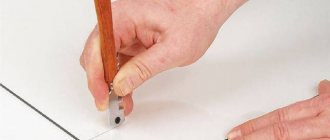When arranging bathrooms and toilet rooms, the walls and floors of which are usually tiled, one cannot do without such procedures as installing pipes and installing electrical sockets. To carry out these activities and obtain a high-quality result, it is important to know how to cut a hole in a tile and what tools and equipment to use for this.
A hole in the tile can be made either using a special tool or using improvised means
Using an angle grinder
The question of how to make a large hole in a tile arises in cases where it is necessary to install pipes or other plumbing communications in a bathroom or toilet, and also, if necessary, install an electrical outlet in these rooms. If the tiles are not yet fixed to the wall, then you can make a hole in this product for a pipe or socket using a regular grinder.
Start cutting a round hole with a grinder by stepping back slightly inward from the intended circle
Using a grinder, a shaped or round hole in a ceramic tile is made in the following sequence:
- The contours of the future hole must first be marked, for which you will need a marker.
- The angle grinder should be equipped with a diamond blade designed for dry cutting.
- You need to start cutting from a convenient edge of the tile, moving the tool away from you.
- When cutting a hole in a tile for a socket or pipe, you can stop at any time and start processing from a more convenient side, but then there is a chance that the cut lines being formed will not converge.
It should be kept in mind that you should only use a grinder to create a shaped or round hole in ceramic tiles from the front part of the product. At the same time, it is necessary to control that the cut is smooth, neat and without chips. When performing this procedure, strict safety precautions must be followed to minimize the risk of injury.
Safety precautions
The device heats up from the mains, so you need to be careful when working with it. This condition must be met, otherwise you may get burns or damaged items. Safety regulations:
- The soldering iron itself should always be supervised.
- Place on the stand during operation.
- A faulty device must be repaired before work.
- Do not touch the tip of the mechanism or the heated glue.
- Turn off when finished working.
Using a jigsaw
Holes in tiles intended for placement of sockets or for installation of pipes can be made using an electric jigsaw equipped with diamond-coated wire. Such a device can be used both to start forming a hole from the edge of the tile, and for drilling carried out in the center of the workpiece. In the latter case, it is necessary to make a preliminary hole, for which an electric drill with a drill is used.
To cut tiles with a jigsaw, use special ceramic files.
The procedure for drilling a hole of significant diameter in a tile, for which an electric jigsaw is used, is performed in the following sequence:
- On the front of the tile, the edges of the future hole are preliminarily marked.
- If part of the resulting contour coincides with the edge of the tile, you can immediately begin processing.
- If the contour does not coincide with the edge of the tile, then a small diameter hole should first be drilled in the workpiece, into which the cutting thread of an electric jigsaw must be threaded.
- A circular or figured cutout is made along the inner contour of the marking. This will allow you to maintain the size of the hole being formed.
Secure the tiles with a clamp before cutting
Using the method described above, a shaped or round hole in a ceramic tile can be made using a regular hacksaw. However, in this case, the quality of its execution will be significantly worse than when using an electric jigsaw.
Romantic (tape recorder)
"Romantic"
- a trademark of portable tape recorders popular in the USSR, produced by the Gorky Plant named after. G.I. Petrovsky since 1965 (and later - at the actuator plant in Petropavlovsk).
Content
- 1 Model range 1.1 “Romantic” (M-64)
- 1.2 "Romantic-3"
- 1.3 "Romantic-304"
- 1.4 "Romantic-306"
- 1.5 "Romantic-201-stereo"
- 1.6 "Romantic-202"
- 1.7 "Romantic-309S"
- 1.8 "Romantic-311-stereo"
Model range [edit | edit code]
"Romantic" (M-64) [edit | edit code]
Model 1965, one of the first Soviet portable transistor tape recorders for the consumer market [1]. Class III tape recorder, reel-to-reel, monophonic, two-track, tape speed - 9.53 cm/s, reproducible frequency range - 60...10000 Hz, output power 0.8 W, dimensions - 330x250x150 mm, weight without batteries - 5 kg, supply voltage - 12 V. Could be powered by eight 373 elements, an external rectifier, a car's electrical system, etc. The tape drive mechanism - with one DC commutator motor, the rotation speed is stabilized by a centrifugal regulator, which operates through a transistor switch. The tape recorder is assembled on a light alloy frame and placed in a casing made of thin sheet steel with plastic covers, trimmed with colored synthetic film. The electronic part includes 17 germanium transistors and 5 diodes; it is assembled by surface mounting on getinax boards. The tape recorder was supplied with a microphone, an external power supply and a leatherette bag. The retail price in the 1960s was 160 rubles, cheaper than tape recorders of the same class at that time (“Spring-2” cost 190 rubles, “Orbita-1” - 180, “Yauza-20” - 200) [2]. The design of the first “Romantic” has much in common with the “Portable tape recorder on transistors” by Yu. Zyuzin and E. Petrov, which was described in detail in 1963 in the magazine “Radio” as an amateur development [3].
Processing tiles with improvised tools
The question of how to cut a hole in a tile if you have neither an electric jigsaw nor a grinder at hand can be solved using improvised means. An ordinary glass cutter, tongs or pliers can be used as such means. When using them, you can make a hole in the tile using the following algorithm:
- Preliminarily outline the contours of the future hole.
- To make the tile material more pliable, the product can be kept in warm water for some time.
- Using a glass cutter, a furrow is made along the intended contour. In this case, the working part of the tool must not be torn off the surface of the tile. When cutting a furrow, significant pressure is applied to the tool, taking care not to damage the workpiece.
- The cut made on the surface of the tile must be tapped with the head of a glass cutter to make the groove deeper.
- The cut section of the tile is removed using tongs or pliers, piece by piece, until a hole with relatively smooth edges is formed inside the cut line.
- To smooth out the edges of the cut, you can use fine-grit sandpaper.
Use a wooden block with sandpaper wrapped around it for sanding.
The design and principle of operation of a hot glue gun
You need to know how the device works so that you can make it at home with your own hands.
The design of the pistol is simple. The mechanism is a manual device where polyurethane glue is heated to the desired temperature. The device is charged from behind using cylindrical rods of different calibers. The rod passes the pusher bushing, the rubber receiver, and then it ends up in the chamber, where, under the influence of high temperatures, it acquires adhesive and penetrating ability. The process lasts 3–5 minutes. When you press the trigger, the rod begins to function like a piston. It creates pressure in the melting tank, and, using a nozzle, displaces the glue onto the surface to be finished.
How else to drill a hole in tiles
Home craftsmen often have a question about how to make a hole in a tile that is already fixed on the wall. In such cases, a hole in the tile can be created using a cone or twist drill.
Processing using a conventional drill takes place in several stages.
- Paper tape or adhesive tape is glued to the place where drilling is to be done, which will prevent the drill from slipping off the smooth surface of the tile and protect it from scratches and other mechanical damage.
- The center of the future hole is marked using a regular marker.
- After this, they begin to make a hole in the tile at low speeds of the drill.
- To prevent the drill from overheating, it must be moistened with water from time to time. After the tool goes deep into the material being processed, you can cool the tile itself.
If you need to make a hole of a large diameter in the tile, you can carry out this process in stages - using tools of various sizes. You can also get a large-diameter hole in a tile using another method, which involves making a large number of small-diameter holes along its contour. Then the inside of the hole is simply knocked out along its contour, and the edges are sanded.
Forum of the site www.analog.pro
This forum is primarily intended for fans of analog sound. And also for music lovers, collectors, musicians, sound engineers, DIYers, etc.
- Links
- Unanswered messages
- Active topics
- Search
- Users
- our team
AKAI GX215D
- For print
AKAI GX215D
- Quote
Post by nksys » Oct 28, 2016 11:37 am
Greetings to all forum members and magnetic recording enthusiasts. After a very long break from creative activity and normal life, I have finally returned and I want to make a few reviews, unless of course they are of interest to anyone else, I would really like to hear the answer to this question)).
So AKAI GX215D is a household two-speed four-track stereo reel-to-reel deck, introduced by AKAI back in 1975.
Extractor
This tool is specially designed for unscrewing a spinning bolt, removing the remains of broken fasteners or any parts remaining inside the holes.
The principle of its operation is to drill a hole in the center and then jam the hole with an extractor. How deep it is placed depends on how worn the head and shank are, and how corrosion affects the threads.
There are several types of this tool:
- Blade;
- Kernel;
- In the form of a spiral;
- In the form of a screw.
All methods and instructions for use can be found in the instructions for the extractors.
Features of zinc
Metal is necessary and widely used in almost all areas of daily human life.
Mining is mainly carried out in Iran, Kazakhstan, Australia, and Bolivia. In Russia, the manufacturer is OJSC GMK Dalpolimetal.
It is a transition metal, has an oxidation state of +2, a radioactive isotope, a half-life of 244 days.
Aqueous cadmium, zinc and copper arsenate
The element is not mined in its pure form. Contained in ores and minerals: cleiophane, marmatite, wurtzite, zincite. It is necessarily present in an alloy with aluminum, copper, tin, and nickel.
Preparatory stage
In order to unscrew a bolt or any other threaded fastener, you first need to prepare it. This stage can be summarized in 4 steps.
Let's take a closer look at each of them:
- Remove rust or contamination - this is the very first step, since without cleaning the contamination, you simply will not get to the threads.
- Tap the bolt - the knocks should be strong. This contributes to the destruction of the oxide layer. As soon as you feel that the bolt has begun to move out of place, you can stop trying.
- Heat the bolt - this stage is quite dangerous, since it involves direct exposure of the bolt to open fire. A torch, soldering iron or acetylene torch is suitable for heating. During heating, rust is removed from the hole and the fastener moves freely.
Use special products - we are talking about special anti-rust sprays or products that have high fluidity. The substance saturates the bolt well and helps to remove the bolt quite quickly.
The only drawback is that the product must be left for several hours for improved impregnation.
What are corrugations needed for, their characteristics
The most widely used are polyvinyl chloride, polyethylene, polypropylene, polyamide and metal channels. In appearance, these products are corrugated pipes with a thin steel string inside. This wire (called a broach) performs the function of a probe, facilitating the cable laying procedure. There are also cheaper options without pulling: it is much more difficult to lay wires in them.
Corrugated pipe with broach
The performance characteristics of corrugated tubes depend on the material they are made of. For example, steel products demonstrate greater mechanical strength and resistance to open flame. Plastic models have dielectric properties and are lightweight. The popularity of polyvinyl chloride tubes is explained by their low cost and self-extinguishing ability.
To make it easier to choose a corrugation that suits its characteristics, these products are painted in certain colors, according to European standards:
- White. Arrangement of computer communications.
- Grey. Installation of electrical wiring of various types.
- Brown, black. Switching to the electrical network of powerful household appliances.
- Green. Laying telephone lines.
- Red. Organization of wiring in outdoor conditions.
- Yellow. Connecting gas equipment.
- Blue. Arrangement of water supply.
Algorithm for checking battery voltage
To check the battery voltage at idle, you need to remove the positive wire from the generator terminal to eliminate sag due to the influence of vehicle loads or possible leaks. Fans of precision can also disconnect the negative terminal . The multimeter mode switch must be switched to the DC voltage measurement mode (V=). Many tester models will display DC symbols on the display.
Multimeter in DC voltage measurement mode.
The measured voltage will indicate the charge level of the battery.
| Open circuit voltage, V | 12,6 | 12,3-12,6 | 12,1-12,3 | 11,8-12,1 | 11.8 or lower |
| Charge level, % | Full charge (100%) | 75 | 50 | 25 | Fully discharged (0%) |











